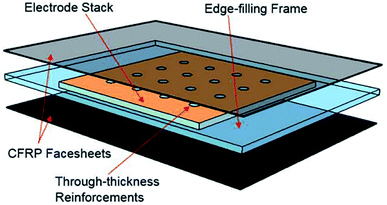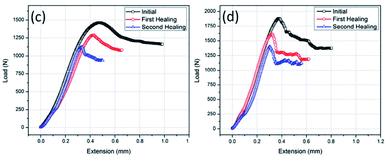 Open Access Article
Open Access ArticleProperties of multifunctional composite materials based on nanomaterials: a review
Alamry Ali ac and
Andri Andriyana*b
ac and
Andri Andriyana*b
aCenter of Advanced Materials, Department of Mechanical Engineering, Faculty of Engineering, University of Malaya, 50603 Kuala Lumpur, Malaysia. E-mail: Kva180033@siswa.um.edu.my
bCenter of Advanced Materials, Department of Mechanical Engineering, Faculty of Engineering, University of Malaya, 50603 Kuala Lumpur, Malaysia. E-mail: andri.andriyana@um.edu.my
cDepartment of Mechanical Engineering, College of Engineering in Al-Kharj, Prince Sattam bin Abdulaziz University, Al-Kharj 11942, Saudi Arabia. E-mail: a.alamry@psau.edu.sa; Fax: +96611 588 8888; Tel: +96611 588 8888
First published on 24th April 2020
Abstract
Composite materials are being used for high-end applications such as aviation technology, space ships, and heavy equipment manufacturing. The use of composite materials has been observed in recent advancements in the field of multifunctional composite materials (MFCMs). There is continuous progress related to improvements, innovations, and replacement of metals inspite of rigorous destructive and non-destructive testing, proving the toughness and lifelong durability of such materials. The present study aims to review the topics relevant to modern multifunctional composite materials. The reviewed articles mostly cover the field of MFCMs based on nanomaterials. The structural functions emphasize on the mechanical properties such as fracture toughness, strength, thermal stability, damping, stiffness, and tensile strength. The non-structural properties include biodegradability, thermal conductivity, electrical conductivity, and electromagnetic interference (EMI) shielding. The study has concluded that the applications of multifunctional nanoparticle-based composite materials and structures include durable but light-weight aircraft wings, components and structures of electric self-driving vehicles, and biomedical composite materials for drug delivery.
Introduction
The remarkable structural and non-structural properties of multifunctional composite materials (MFCMs) have resulted in an increase in their industrial applications. There are two aspects of the composite materials, viz., development/production and physical/mechanical properties. The emphasis of the surveyed publications is on the mechanical properties of MFCMs; however, the nature of the study leads to the inclusion of some research papers on related topics such as electronics, material science, and thermodynamics. A majority of the surveyed articles deal with composites with diverse compositions, which can be called as polymer composite materials. The need for the development and use of MFCMs has shown a significant rise in the last 2 decades. In the past seven years, from 2010 to 2017, MFCMs have found numerous applications in the field of construction, production, and development of multidisciplinary equipment. The traditional practice was to develop a composite structure, which could bear heavy loads, while other non-functional properties were often neglected. The composites were aided with materials having the required properties for any other needed property, resulting in a heavy structure with multiple layers. Apart from the increase in mass, the resultant composite materials had delamination issues that were observed after a specific period. The MFCMs deal with improvements in both the load-bearing functional properties and allied properties simultaneously. The non-functional properties are now an integral part of the MFCMs.The research in this field is associated with the continuous development of new materials, combinations, and properties that are being achieved with the accomplishment of each study. The advancements in MFCMs have already been covered up to the year 2010 by Gibson.1 The recent developments, however, have created a reasonable need to summarize the improvements and innovations in these materials during the last 9 years from 2010 to 2019. The present study has covered the most recent publications from renowned journals and research conferences. While the number of relevant publications in 2010 was more than 200 per year, it grew to nearly 580 publications per year during 2016.2 Fig. 1 illustrates the numerous applications, required properties, and significance of MFCMs used in recent times.3
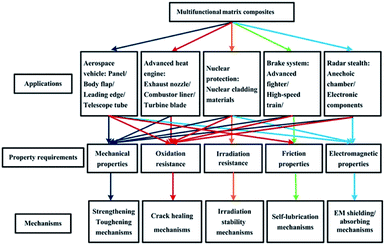 | ||
| Fig. 1 Block diagram representing the multifunctional matrix composite applications, key properties, and mechanisms.1 | ||
The requirement for the materials has led to some major developments that can deliver both multiple structural functions and non-structural functions in the field of MFCMs. The example of a material with multiple structural functions is the one possessing high fracture toughness, high strength, high damping, and high stiffness. Similarly, the example of a material with non-structural functions is the one with high load bearing capacity along with noise and vibration suppression. Other properties such as thermal insulation, energy storage such as in batteries, and self-repair have also been included. There is a third type of material that bears both multiple structural functions and non-structural functions. Major research and development have been achieved in both types of MFCMs. The present study aims to review the recent developments and evaluation of functional and non-functional properties of multifunctional composite materials based on nanomaterials. The articles reviewed in this study mostly cover the field of MFCMs based on nanomaterials.
Related work
The interest in the field of MFCMs has resulted in a significant number of publications and review papers. Ferreira et al.2 stated numerous types of MFCMs and their possible applications in the field of civil engineering, medical applications, transportation equipment, energy storage, and conversion; on the other hand, Kumar and Anthony emphasized on matrix composites reinforced by graphene.4 Similarly, Liu et al.5 reviewed the impact of mechanical drilling on composite laminates such as graphene fiber reinforced plastics, carbon fiber reinforced plastics, and fiber metal composite laminates. This has provided an inclusive vision on the mechanical drilling of composite laminates. Loh et al.6 introduced naturally degradable MFCMs from sugarcane bagasse (SCB) and attempted to discover reliable properties and applications of SCB for composite materials.Lubineau and Rahaman7 have studied the recent advancements in the improvement of degradation properties of MFCMs by using epoxy filled with carbon-based nano-reinforcements.7 The crack initiation and its propagation in multifunctional polymer composites was studied by Naebe et al.,8 which discussed the development of nature inspired self-healing and autonomic repair in composite materials. Similarly, a specialized study conducted by NASA showed the fatigue properties and mode-II inter-laminar fracture toughness of multifunctional graphite epoxy composite material.9 Another study conducted by Pang et al.10 showed that the properties of conductive polymer composites (CPCs) were due to segregated structures. The study also investigated the ultralow percolation behavior, EMI shielding, and thermoelectric shielding of CPCs. However, an increase in the strength of MFCMs was observed and achieved by Qian11 using carbon nanotubes as the filler for such materials. The study provided a detailed summary of the improved electrical, thermal, and mechanical properties by reviewing the multifunctional polymer composite filled with carbon particles and absorption of microwaves in such materials. Another study explored by Brosseau stated the impact of geometry, morphology, and composition of carbon particles on the absorption of electromagnetic radiations.12
Rafique et al.13 have explored epoxy resins and hardening systems using carbon nanotubes for high performance materials used in aviation. On the other hand, a detailed review on the mechanical properties of MFCMs was conducted by Al-Saleh and Sundararaj14 by testing the tensile properties, fracture toughness, dynamic mechanical properties, and rheological properties. The results depicted a significant impact of the processing conditions and methods on the properties of the VGCNF/polymer composites. Armentano et al.15 conducted a comprehensive study in the field of bio-nano multifunctional composites showing the properties, current trend, and prospects of poly lactic acid (PLA) based materials. The study investigates the application of such composites in tissue engineering and PLA modification techniques.15 The green composites (nature based multifunctional materials) were studied by Dicker et al.,16 which showed that green composites have potential to be used in several applications. Another study included the review of mechanical properties, variable fiber properties, renewability, biodegradability, and toxicity of multifunctional green composites.17 The results depicted that natural composites show good potential in infrastructure applications because of their positive economic and environmental outlook and their ability to meet human needs.
Few of the previous studies have worked on the multifunctional cementitious composite materials.18,19 These studies have emphasized on the mechanical properties and improvements due to the addition of multilayer graphenes. The study reported an increase in the compressive strength and reinforcement by about 21% of that of the original material. The addition of multilayer graphenes proved to be effective as nano-scale fillers for multifunctional cementitious composites.20 The addition of multifunctional core–shell multifunctional nano-particles into the composite materials showed significant improvements in the properties such as anti-corrosion, enhanced surface chemistry, electromagnetic resistance, and microwave absorption.21 Cui et al.22 conducted a study on multifunctional cementitious materials by emphasizing the structural functions such as mechanical, electromagnetic, and thermal properties, modified by nano-graphite platelets.
Multiple structural properties of MFCM
Specific properties in conventional composite materials are achieved by changing the composition or adding various strengtheners and stiffeners. However, the development of a multifunctional composite material embedded with multiple structural functions remains a challenge for scientists and researchers.2 The most important structural properties expected from a multifunctional composite material are fracture toughness, strength, ductility, stiffness, thermal stability, and energy absorption. Recently, continuous research in this field has achieved some milestones, where composite materials that can survive in real-world situations have been developed.23 The weight of the composite material is one of the most important design considerations during the development of light-weight materials, although it is not considered as a structural function. Mecklenburg et al.24 have described a composite material that is light-weight and extremely robust under deformation loads. The material functions were achieved through chemical vapor deposition (CVD) synthesis of the material with freely adjustable zinc oxide (ZnO) molecules.The improvements in the mechanical properties have already been observed by adding nanoparticles in composite binding agents. This method of enhancing the mechanical properties remains a deep area of interest among scientists and researchers for developing MFCMs. A study conducted by Zhang et al.25 showed significant improvements in the mechanical functions and sand erosion resistance of glass fiber epoxy reinforced polymer composites. MFCM was used due to its ability to provide EMI shielding apart from the improvement in the mechanical strength. The flexural strength increased by 24% when carbon nano-fiber paper was used between the layers, as shown in Fig. 2. Zheng et al.26 stated that ultra-light and ultra-stiff composite meta-materials were prepared by modifying the ordinary structures to nearly isotropic micro scale unit cells with improved structural binding. The process used to develop these structures was termed as micro stereolithography, based on nano-scale coating and post processing. The use of single and multi-walled carbon nano-tubes have already shown significant improvements in the overall structural functions of composite materials.27,28 These studies have shown that the addition of CNTs increases the toughness from 36 to 53%, depending on the extent of dispersion in the epoxy.27,28
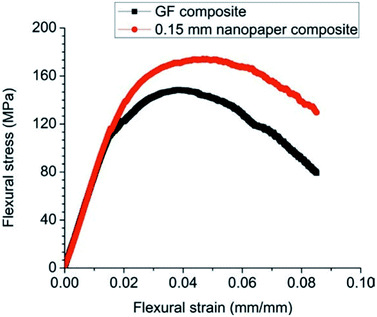 | ||
| Fig. 2 Comparison of flexural stress against strain for glass fiber composite with and without nano-paper enhancement.25 | ||
In another study, the effect of CNT alignment, CNT types, and their concentration showed that unidirectional CNT alignments were greater than 10% by weight. The increase in the CNT alignments resulted in a significant reduction of the gauge factors and mechanical strength of the composite materials.29 The characterization of thermal and electrical conductivity for the mixtures of CNT filled epoxy showed a 5.5% improvement in the thermal conductivity, as depicted in Fig. 3.30 All the properties may not improve even in MFCMs; however, a reduction in the undesired properties is usually not a great concern on improving the desired properties. For example, the addition of micro-particles of rubber in an epoxy binder and their orientation in glass fiber composite material caused a 3-fold increase in the tensile fatigue, while there was 12.7% reduction in the elastic modulus and 5.2% reduction in the tensile strength.31 Mixing silica particles in epoxy caused a 12.3% increase in the modulus and a 3.6% increase in the strength, causing a reduction in the coefficient of thermal expansion by up to 14.2%.32
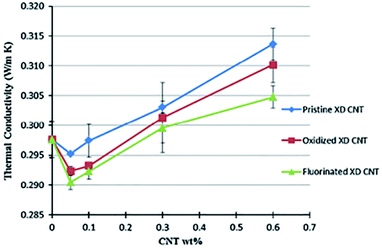 | ||
| Fig. 3 CNT wt% vs. thermal conductivity for multifunctional composite materials.30 | ||
Micro and nano filler-based hybrid MFCMs
The addition of CNT, SWCNT, and MWCNT in the epoxy matrix of composite materials enhances the mechanical properties such as stiffness, fracture toughness, and load bearing. A significant number of recent studies has shown that the addition of conventional micron scale particle and fiber reinforcements along with CNTs have shown significant improvements in the properties of MFCMs.33,34 Fig. 4 illustrates the SEM image of CNT and TEM image of polycarbonate in the composite matrix while Fig. 5 shows the effect of presence of these fillers at the nano and microscale on the specific notched impact resistance. It shows that the maximum toughness of the composite materials increases by 435% when using the combination of CNT and polycarbonate.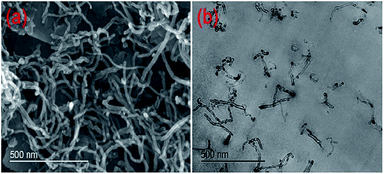 | ||
| Fig. 4 (a) SEM image of CNT (b) TEM image of polycarbonate/2% CNT.33 | ||
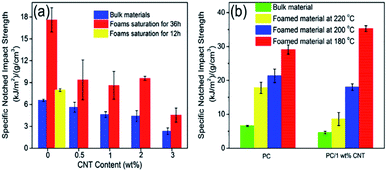 | ||
| Fig. 5 The comparison of presence of CNT and polycarbonate/CNT on the specific notched impact strength.33 | ||
These fibers have higher elastic modulus and longitudinal strength, when combined with conventional polymer composites, resulting in enhanced matrix dominated transverse strength. Such composites have poor longitudinal compressive strength properties. Several efforts have been made to improve this poor longitudinal compressive strength by embedding nano-enforcements on the surface of the fiber.35 The other method is to replace the pure resin polymer matrix with filled nano-particles.36 In such conditions, plastic deformation induced by empty spaces absorbs the impact energy, resulting in high impact and compressive strength.
Kaizer et al.37 have reported an improvement in both the modulus and longitudinal compressive strength, which was obtained by adding silica based nano particles in epoxy. The problem with the addition of silica particles was the presence of equal-distribution of silica particles among the polymer matrix, which was achieved by the sol–gel process. A reduction in the matrix cracking and improvement in the fatigue life by using sol–gel formed nano-silica in the epoxy matrices was achieved, although the process is old. The presence of both micro and nanoscale silica particles showed further improvements in the structural functions and mechanical properties of the composite materials. The increase in the proportion of nanoparticles also increased the value of Young's modulus. However, there was no impact on the concentration of micron size particles.37
Studies on the addition of MWCNTs in epoxy for composite materials have shown greater improvements in the fracture toughness, strength, and other mechanical properties.38–40 Gallego et al.38 have compared the mechanical properties and filler percolation in multifunctional nano-composite. The study shows that the highest increase in the mechanical properties is achieved only when the network distribution of filler is created within the composite matrix. In the study, CVD technique was used to synthesize the MWCNTs, resulting in a specific surface area of 50 m2 g−1.39 Similarly, functionalized graphenes were also synthesized and used in the epoxy matrix for comparison. The cured samples were tested and the results showed that there were noticeable enhancements in the overall strength and elastic modulus of the composite material.40 The highest values for the composites were obtained by introducing graphene sheets, as shown in Fig. 6.
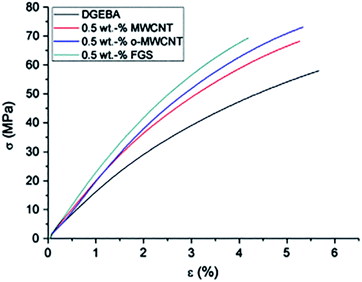 | ||
| Fig. 6 Stress–strain curves for various compositions of filler materials.38 | ||
Another study focused on the multi-scale toughening of MFCMs using carbon nano fibers and macro size Z-fibers.39 Z-pinning is a specialized technique for inserting reinforcing fibers in the Z-direction. Z-fibers can be developed as a unidirectional fiber inside the composite material. The study showed that there was nearly 400% increase in the inter-laminar fracture energy using the combined effect of nano and macro scale fiber reinforcements. This multifold increase was due to the multiplicative effect due to the interplay between extrinsic and intrinsic strengthening at the crack tip. Along with these improvements, a 2% decrease in the tensile strength was also observed, which is always acceptable for multifold setback on the other side. Fig. 7 shows the inter-laminar fracture toughness for various reinforcement types and combinations.
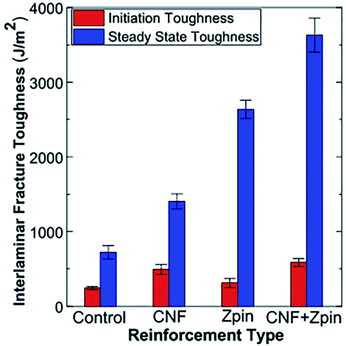 | ||
| Fig. 7 Comparison of inter-laminar fracture toughness against various combinations of composite reinforcements.39 | ||
A major part of the study on MFCM involves the increase in the mechanical properties; however, Sanaty-Zadeh40 reviewed the MFCM's surface properties. The results depicted that the models for predicting material toughness normally ignore the Hall–Petch effect even though it is one of the important considerations while modeling the strength of a metal matrix composite. The resultant composite material can gain 34% improvement in the overall strength and fracture toughness. Some of the more recent and advanced approaches involve the development of CNTs on the microspheres of alumina (Al2O3) and using them as reinforcement in MFCMs.41 The composite materials showed a 26% improvement in the Young's modulus. Along with the improvements in the mechanical properties of the composite, significant improvements in the thermal diffusivity (56%) and electric conductivity (92%) by the addition of nano-coated alumina microspheres have been reported. Ulus et al.42 have used hybrid fillers for the improvement of mechanical properties of composite materials. The hybrid fillers were MWCNTs along with nano-plates of boron nitride. The result showed an increase in the static toughness by about 53%, increase in the strength by about 20%, and increase in the elastic modulus by about 10%. In another study, an increase in the interfacial strength up to 83.4% was reported for the ZnO based filler developed on p-phenylene benzobisoxazole. The resultant MFCF showed significant improvements in the hydrothermal aging resistance.43
Koricho et al.44 showed the effect of nano and micro fillers on the impact resistance of glass fiber reinforced plastic composite materials. The hybrid materials chosen for testing were glass bubbles iM16K (micro filler) and Cloisite 30B nano-clay. It was observed that the addition of 1 wt% of glass bubbles improved the dimensional stability because of the increased inter-laminar thickness and reduced shrinkage. The material was recommended as a light-weight substitute for vehicle applications such as bumper subsystem. Other studies involving MgO nano-particles and carbon fiber hybrids have also shown noticeable improvements in the mechanical properties as well as increased thermal conductivity up to 20%.45 Similar improvements in the mechanical properties while attaining a 200% increase in the thermal conductivity were achieved by using silicon carbide-CNT hybrid with polyvinylidene fluoride.46
Integrated structural and non-structural properties of MFCMs
The addition at the micro and nano levels for enhancing the properties has helped in achieving improvements in both the structural and non-structural properties. Multiple level improvements have resulted in an increased scope of MFCMs.Electrical energy storage
It has already been proposed to eventually shift the load of the transportation system from fossil fuels to electricity-based vehicles with growing environmental concerns. Some well-known names such as Tesla are already working in this field. However, energy storage is a major setback that is preventing the electric vehicle technology from flourishing. The conventional Li-ion and Li-polymer batteries, and similar technologies are still unable to power electric vehicles that can perform with fossil fuel vehicles. Different solutions have been introduced in the past few years, with a paradigm shift towards electricity-based transport vehicles and the intensely growing need to develop a reliable mechanism of electricity storage.Asp47 have demonstrated the applicability of commercial intermediate modulus fibers that were designed and developed for structural batteries. It was found that for sized carbon fiber composite in the batteries, the electrochemical capacity was doubled. However, the manufacture and integration of sized carbon fibers in the composite is problematic and needs further study. Balogun et al.48 have conducted a study in which for a high-performance electrode, metal nitride composites were used for energy storage. Another study conducted by Balogun et al.49 showed that as a replacement of lithium ion batteries, sodium ion batteries were used based on carbon composite anodes. In a detailed study on multifunctional energy storage composites, the design, development, and characterization were studied by Ladpli et al.50 The concept was to use multifunctional energy storage composites to house the electrochemistry of the cell between face-sheets. The experimentation involved the fabrication of 4 A h capacity batteries having various reinforcement array configurations. Fig. 8 shows the configurations of the conventional Li-ion battery and the multifunctional energy storage composite. The detailed construction of the composite is illustrated in Fig. 9.
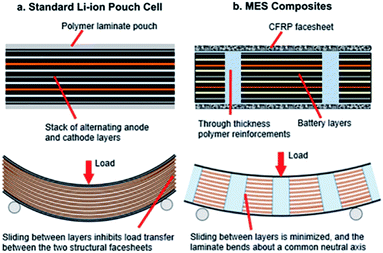 | ||
| Fig. 8 Comparison of conventional Li-ion and MES composite batteries.50 | ||
The batteries were then tested using electrochemical performance tests and mechanical electrical coupling tests. The results from the studies were based on electrochemical characterization as well as mechanical testing. The electrochemical characterizations show that capacity retention of the composite batteries, when compared to initial discharge capacity, was over 96% after 200 charge discharge cycles. Qu et al.51 worked on electricity storage in layered SnS2 reduced graphene oxide composite to produce higher rate and higher capacity battery anode material. The results showed that SnS2-reduced graphene oxide demonstrated high charge specific capacity (630 mA h g−1) and long charge discharge cycle life (Fig. 10).
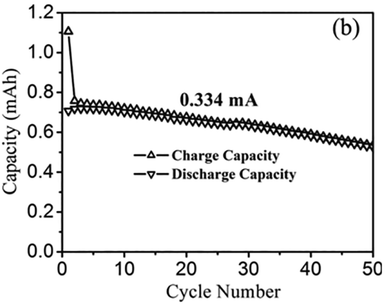 | ||
| Fig. 10 Cycling performance of SNS-reduced graphene oxide composite battery anode.51 | ||
Raccichini et al.52 showed that graphene has a significant function in electrochemical energy storage devices even though it is not actively involved in the chemical reaction. Graphene composite layers were used for encapsulating the carbon matrix and as a conductive agent for anodes, resulting in efficient electron transport. Fig. 11 shows various configurations developed through graphene composites for making electrodes in the batteries.
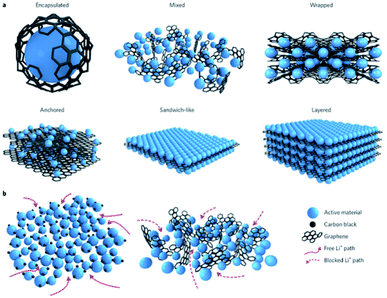 | ||
| Fig. 11 Structural models for graphene-based anode composites.52 | ||
A review on the application of multifunctional composite materials based on 3D graphene for energy storage was published by Wang et al.53 The study shows that this graphene based composite material provides multidimensional paths for electron transport, thus reducing resistance to the flow of electrons. The study shows that if a 3D graphene-based material is doped with metal or metal oxide ions, it further improves the electrical storage and conductivity in Li-ion batteries. A similar review on hybrid composite material-based anodes in Li-ion batteries was published by Zhu et al.54
Super capacitance
A major setback is charging time, although hybrids of multifunctional composite materials used as anodes in conventional batteries have improved the charge density per unit area. Overnight charging time is not feasible for mass acceptance if it must be used in transportation vehicles. Several researchers have plunged into the field to develop an alternative of conventional energy storage devices.54–56 The concept of supercapacitor emerged as a solution for increased current density per unit area. The goal is to achieve a current density of 250 W h kg−1 at a cost of $125 per kW per h to run a mid-sized sedan on electric charge for about 300 miles.57The use of multifunctional composite materials for making supercapacitors improves the electrical properties and structural functions. The robust nature of the composite material makes it as a perfect choice to be used in conventional applications such as electric vehicles. Carbon fiber reinforced composites have a positive influence on the electric storage properties.58 Superior supercapacitance can be achieved by grafting the hierarchical nanostructure of Ni–Mn-layered double hydroxide microcrystals over carbon nanotube composites, as shown in Fig. 12.59 The capacitance achieved was 2960 F g−1 with good charge/discharge cycle-ability.
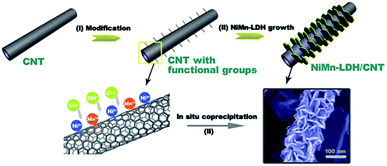 | ||
| Fig. 12 Synthesis of Ni–Mn-double layered hydroxide composite for super capacitors.59 | ||
Augustyn et al.60 have found that the crystal structure affects the capacitance of supercapacitors. A wide intercalation tunnel results in higher capacitance values on using MnO2 in aqueous electrolytes as thick composite electrodes. Similarly, Staaf et al.61 have found that composites containing CNT yield higher capacitance and high number of charge/discharge cycles. The high di-electric constant nano-composites have also shown potential for energy storage. These materials were prepared by core–shell nano-architecture strategies.62 The study has shown that other polymer composite materials such as poly-oxometalate functionalized carbon nanotubes deliver reliable performance for energy storage and charge/discharge cycles. These composites have achieved a four-fold increase in the capacitance when compared to MWCNTs integrated in double layers.63,64 Shayeh et al.64 have worked on conductive polymers and Au particles as efficient composite materials in electrochemical supercapacitors, which showed excellent charge density properties and charge retention. Carbon based composite materials have also shown super capacitance; however, more research needs to be done for practical durability of this technology in future.65
Thermal conductivity/insulation and storage
Multifunctional composites have been studied for their use as thermal insulators for energy conservation applications, thermal conductors for efficient heating or cooling a system, and as thermal storage for energy generation. Thermal insulators are available in various sizes and shapes, which possess poor mechanical properties. The use of multifunctional composites brings in benefits of both thermal insulation as well as mechanical strength. This benefit results in the elimination of the need to cover up the whole equipment or installation with insulation, while it itself acts as a part of the structure.66 The ultra-low density (0.072 g cm−3) graphene aerogel composites have high strength and have found their applications in the aerospace field. N-doping graphene aerogels were prepared for thermal conductivity of composites, which were reinforced by micro sized quartz fibers as low as 0.0327 W (m K)−1, when measured by a hot disk apparatus. The anhydrite/aerogel composite was used for thermal insulation. The process used for the development of the composite was hydrophilization of the particles of hydrophobic silica aerogel in a surfactant based on the polymers. The fraction of aerogel in the composite of 60% by volume possessed thermal conductivity less than 30 mW (m K)−1.67 Thermal insulation is especially important for energy storage in a thermal power plant. Xu et al.68 developed a ceramic composite material for this purpose based on hollow silica powders and alumina fibers. The results showed significantly lower thermal conductivity in comparison with conventional inorganic insulating materials in the temperature range from 126 to 538 °C. This lower thermal conductivity is attributed to the microstructures formed in the composite material. Fig. 13 illustrates the comparison of conventional insulators and the developed ceramic composite insulation.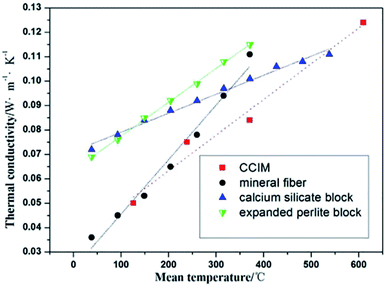 | ||
| Fig. 13 Comparison of conventional insulators vs. ceramic composite insulation material (CCIM).68 | ||
Belayachi et al.69 have also conducted a research in which the effects of dry-wet and freeze thaw cycling on the mechanical and thermal properties of straw-plaster based composite materials, which were proposed for building insulation, were studied. Two straw varieties, namely, barley and wheat, were used as insulation reinforcements in gypsum. There was an increase in the thermal insulation by less than 0.92% for barley and 0.85% for wheat straws, thus recommending the insulation of buildings under regular environmental conditions. Binici et al.70 used epoxy/corn stalk composite for building insulations and reported improved insulation by up to 30% when compared to similar biomaterials. The use of other biowaste materials for thermal insulation has also been reported by previous studies.71,72
Contrarily, some composite materials with good thermal conductivity have been developed for their use in electric batteries or energy storage devices for efficient heat dissipation during charging or discharging.73 A study showed high-density polyethylene (HDPE), carbon nanotubes, and expanded graphite (EG) ternary composites with improved thermal conductivity using the filler network. The thermal conductivity factor “f” for these materials was calculated using the following formula;74
 | (1) |
The development of thermal energy storage materials can help to increase the size of solar heating systems in green house applications and at the domestic level. One of the techniques of storing a substantial amount of thermal energy is by using the phase changing composite materials (PCCMs) that can work at very narrow temperature ranges. A study by Sari75 has reported the results of differential calorimetry for the prepared composites. The resulting latent heat capacity was 38 to 74 J g−1 for the temperature change of 4–30 °C.75 The resultant material achieved a latent heat of 157.43 J g−1.76 The following equation was used to measure the latent heat of the composite material;
| ΔHF-SCPCM = N (%) (ΔHC20) (100%) | (2) |
Some other approaches for energy storage in composite materials were reviewed by Jamekhorshid et al.77 and Pielichowska and Pielichowski,78 where micro-encapsulation methods for phase changing materials were discussed. Similar work in the field of thermal energy storage was done by Trigui et al.,79 where LDPE based composite phase changing materials were used and tested for thermal stability, thermal conductivity, and related thermo-hysical properties. The work has demonstrated various tests that can be conducted for the evaluation of thermal storage composite materials.79 Some other phase changing materials used for thermal storage include nitrogen doped graphene/palmitic acid composite, boron nitride nano sheets, and myristic–palmitic–stearic acid graphite composites.80–82 All these composites have shown substantial improvements in the thermal storage capability to be used in green house applications.
Adsorption
Several solutions are already in use with stringent environmental regulations and a growing trend towards the treatment of wastewater and air pollution. The use of MFCMs for treatment can further augment the objective of protecting the environment. Some newer composites have been developed with the ability to adsorb certain contaminants while retaining their structure under a range of temperature, environmental conditions, and chemical exposure. One of such adsorbents was developed using chitosan flakes for methylene blue removal from wastewater.83 The flakes were dissolved in 0.7 M acetic acid and modified ball clay was added afterwards. The stirring of the mixture was done for 24 hours and then, 0.67 M sodium hydroxide solution was added to form beads. The beads were freeze-dried and crushed to the particle size of 0.5 to 2.0 mm to form the adsorbent composite. This adsorbent was then filled in the fixed bed adsorbed prototype for testing and evaluation. The adsorbent uptake qt (mg g−1) was found by using this equation;
 | (3) |
The adsorption of methylene blue in the chitosan composite was 159% higher than regular modified ball clay. The effect of the initial concentration of methylene blue was also investigated and is shown in Fig. 14. Benhouria84 conducted a study on methylene blue removal, where calcium alginate–bentonite-activated composite beads were used. The adsorbent at 30 °C was able to take up 756.97 mg g−1 of methylene blue and 25 to 500 mg L−1 of the initial concentration.84
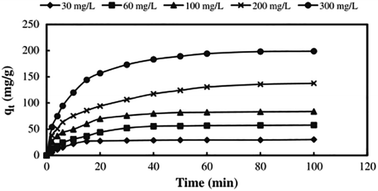 | ||
| Fig. 14 The initial concentration of methylene blue effect on the adsorption at 30 °C.83 | ||
A study was conducted for heavy metals removal, i.e., chromium, lead, mercury, cadmium, and nickel from industrial wastewater using amino functionalized magnetic graphene composite material. The results showed the absorbance values, in mg g−1, of 17.29 for chromium, 27.95 for lead, 23.03 for mercury, 27.83 for cadmium, and 22.07 for nickel.85 In another study, Xie et al.86 showed the removal of cationic and anionic pollutants from wastewater simultaneously by using zeolite/hydrated iron oxide composite material obtained from coal fly ash. The zeolite composite was developed by 24 hours of vigorous stirring of the mixture containing fly ash with solid–liquid ratio of 2 M NaOH and 6 mL g−1 at the temperature of 95 °C. After 24 hours, the mixture was cooled and the zeolite was separated by centrifuging.
Fluoride, if present in higher concentrations, possesses health risks to humans, sea animals, and plants, resulting in fluorosis, osteoporosis, and neurological disorders. The study carried out by Wang et al.87 has reported fluoride removal from water using a magnesium-iron-lanthanum composite. The composite was prepared by co-precipitation method and had an absorbance efficiency of 112.17 mg g−1 for fluoride. Other works for the absorbance of fluoride utilized composites such as zirconium–manganese and calcium–aluminum–lanthanum.88,89 The composite materials have been used for selective gas adsorption as well. Zhou et al.90 showed the separation of a binary mixture of carbon dioxide and methane using graphene oxide and MIL-101 chromium composite. Similarly, Rodenas et al.91 used nano-sheets in the polymer composite for the separation of the CO2/CH4 mixture. These materials can be used as dry gas wells to remove CO2 while utilizing less energy compared to conventional processes. It was found that the use of mixed matrix composite membranes, which contained ZIF-7 nano fillers, showed improved selective separation of carbon dioxide. The polymer composite is easy to fabricate and thus provides a viable industrial scale gas separation solution.92 Individual covalent organic and metal organic framework membrane were used for separating hydrogen and carbon dioxide gas. However, Fu et al.93 showed that two membranes can be combined to develop a composite with higher H2/CO2 separation efficiency.
Self-healing functions
There is still a significant scope for improvement in this field; although, several researchers have worked in the field of self-healing composite materials, any damage can also occur. The encapsulated fluid is released and the propagation of crack is stopped by binding of the fibers as soon as damage occurs. This kind of self-healing mechanism can be used in a large number of applications ranging from domestic appliances to aviation and spaceships.94 The SEM images of the microcapsules of poly-methyl-methacrylate have been shown in Fig. 15.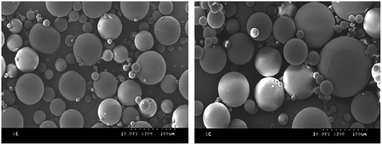 | ||
| Fig. 15 SEM images of encapsulated poly-methyl-methacrylate in the composite material.94 | ||
Kuang et al.95 have reported the self-healing properties of continuous carbon fiber composites. The fibers were integrated into polyurethane, incorporating Diels–Alder cyclo-addition adducts.95 The healing efficiency was tested using short beam shear testing. The composite material showed a healing efficiency of 85% for the first delamination and 73% for the second delamination, as shown in Fig. 16.96
Huynh et al.97 conducted a study on carbon nano-structure composites for self-healing chemical sensors. The study involved four conductive materials embedded in three different self-healing polymers, namely, poly-hydroxy-propyl-methacylate, poly-propylene-urethane-urea-phenyl-disulfide, and poly-urethane-carboxy-phenyl-disulfide. The resulting polymers were flexible electric conductors with self-healing properties.97 The glass fiber reinforced composite materials were widely utilized in many applications. Sordo and Michaud98 reported the self-healing and damage recovery properties of glass fiber reinforced composite (GFRC). Supramolecular hybrid network matrix was employed in GFRC by vacuum assisted resin infusion molding process. The results showed damage recovery for flexural properties such as 65% maximum flexural stress and 72% elastic modulus.98
Apart from encapsulation, the study revealed advanced self-healing mechanisms such as highly dynamic supra molecular systems, pyridine–metal bonds, quadruple, and sextuple hydrogen bond.99 These composites exhibited high storage moduli with self-healing properties. One of the studies also used self-healing composites based on organic material such as soy protein and micro fibrillated cellulose.100 The results showed self-healing efficiency of up to 27% for soya protein isolate. The composite was developed using strontium fluoro-aluminosilicate particles and aqueous solution of polyacrylic acids enclosed in silica microcapsules. The resultant composite restrained the micro-cracks without the involvement of external aid.101
Fire-retardant properties of MFCMs
The use of polypropylene based composites is increasing due to their flexibility and electrical conducting properties. Polypropylene is a low cost and transparent polymer with low strength; however, the composites developed from polypropylene by adding glass fibers are tough to fracture due to their improved mechanical properties. These composites find their use in domestic and high-end applications such as aviation and spaceships.102 The problem with these composites is that they are easily flammable. Zhang et al.103 have worked in this area and studied the effect of carbon nanotubes on intumescent flame-retardant composites. From the thermogravimetric results, the resultant composite had increased thermal stability in the presence of intumescent flame retardants.103 The polymer was embedded with ultrafine kaolinite to develop a fire-retardant nano-composite material. The thermal and thermo-oxidative degradation of ethylene vinyl acetate nano-composite was studied in the range from 300 to 400 °C. The composite was thermally more stable than the neat polymer and could bear temperatures up to 700 °C.104 Some other fire retardants used in composite materials such as magnesium hydroxide, aluminum trihydroxide, zinc stannate, zinc borate, and antimony oxide were discussed by Yang.105The mechanical properties of thermoplastics were enhanced by wood flour waste addition.106 However, with improvements in the mechanical properties, thermoplastics become increasingly flammable. Fang et al.107 found that the addition of zinc borate in the polymer composite greatly enhanced the thermal stability of wood floor PVC composite. Cavdar and Kalaycioglu108 reported that polystyrene waste tea mill wastes and wood flour composite were made fire retardant by the addition of di-ammonium phosphate. The thermal degradation of the composites was tested using thermogravimetric analysis, which showed that the material starts degrading between 267 and 269 °C.108 Another study on flame retardant composites reported melamine containing polyphosphazene wrapped ammonium polyphosphate; the composite had high flame retardancy and smoke suppression. The glass transition temperature for the composite was reported to be 185 °C.109
Bio-degradability of MFCMs
There is a growing concern about synthetic inorganic composite materials due to environmental regulations. Researchers have already begun working on composite materials that are not only recyclable but also biodegradable. Synthetic fiber composites are being replaced by biodegradable natural ones, making them cost effective, low density, and renewable materials for use. One such material was investigated by Pietro et al.110 where Kenaf fiber composites were developed and characterized for their thermal, mechanical, and morphological properties. A detailed study on commercial biodegradable composites and their thermo-mechanical properties showed the role of fillers (nanosilica particles and wood flour), resulting in an increment in the modulus up to 100%. Creep resistance was also shown to increase in the biodegradable composites.111 In another study, Rogovina et al.112 presented a review on the properties and structures of natural and synthetic biodegradable multifunctional composites. The composites were tested for biodegradability by burial in the ground and tested for loss of mass and fungal resistance.112 Fig. 17 illustrates the biodegradability curves of polylactide–chitosan, polylactide–ethylcellulose, polylactide–chitosan–PEG, and polylactide–MCC–PEG.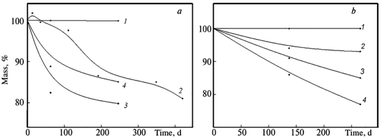 | ||
| Fig. 17 Biodegradability of various composites with respect to time in days.112 | ||
Few of the previous studies have used biodegradable biomaterials for the development of MFCMs such as agarose and composites based on starch reinforced with flax fibers and date palm.113,114 These composites showed a 140% increase in strength when agarose was present in the bio-plastic composite. In another study, biodegradable polylactic acid was impregnated with nanocellulose fibers to make a biodegradable composite material.115 This composite material is hygroscopic and controls the water evaporation rate when applied on some surface. The result showed lower rate of water transmission of 34 g per m2 per day in comparison with the conventional control value of 1315 g per m2 per day. The resultant composite material is biodegradable and thus, can be a promising packaging material in the future. Another biodegradable composite plastic and its characterization was performed by Jia et al.116 The two polymers, namely, polylactic acid and polybutylene, were used as reinforcements in the composite structural system. These biodegradable composites have shown remarkable improvement in their properties such as strength, failure strain, elastic tensile deformation, and fracture toughness. Similarly, Beltrami et al.117 reported similar improvements in the mechanical properties while the biodegradability of the composite material was retained, viz., curaua fiber impregnated poly-hydroxy-butyrate-co-hydroxyvalerate.117
A fully biodegradable composite material was developed as a plasticizer in L-poly-lactide-flax blends by using poly-butylene-succinate.118 The tensile tests were performed after extrusion and injection at 140 °C. It was also reported in the results that the addition of poly-butylene-succinate in adjustable volumes improved the fracture toughness of the composite by 29% and elongation by 17.4%. Pereira da Silva119 conducted a study on fully biodegradable composites, where lignocellulose from residual peach palm trees was used as the reinforcing filler in poly-butylene-adipate-co-terephthalate.
Miscellaneous functions
MFCMs have found applications in several other fields such as antibacterial, water repellant, and food grade materials.120–123 Some advanced MFCMs have been developed for chemical detection.124 The results have shown that the addition of fluoroalcohol in the nano fibers of polyaniline can be used for hydrazine detection. Shirasu et al.125 used CNTs for making a composite material with zero thermal expansion. Luminescent ions in advanced MFCMs have shown environment-friendly photocatalytic properties.126 The magnetizable concrete composite material was based on powdered ferrite, cement, and magnetic material. The aim was to transfer power wirelessly for electric vehicle charging applications.127Sensitivity of mechanical response of composite materials and structures
Composite materials have become an essential aspect for studying the dynamic behavior with respect to the static behavior since composite materials are preferably used over conventional materials in high speed structural applications.128 In addition, they are more suited for the design of dynamically loaded structures utilizing static properties since there is a comprehensive variation in the mechanical properties of the composites with the strain rate. In general, polymers are usually considered in terms of viscoelastic materials because of their mechanical properties, which are suitable for the level at which they are loaded.129 During a crash, high strain-rate loading is caused in thermoplastic composites, which are usually found in automobile aspects, including spare wheel wells, underbody closures, bumpers, front-end-chassis frames, and side impact beams.130The use of polymer matrix composites is usually identified in aerospace industries. The aerospace structures are oriented for dynamic loading during service conditions, which include different kind of debris or high velocity impacts from hailstones. Underwater shock waves can be emitted by sea mines during detonation, which can lead to rigorous effect loading on the naval shop structure through glass reinforced polymeric composites.131 Therefore, their reaction during different conditions of strain rates must be apparently implicit for the effective use of these materials. For high strain rate polymeric composites, uniaxial compression tests are further demonstrated where there is a substantial increase in the strength and stiffness with the strain rate.132 In addition, prior studies have been carried out under one-dimensional stress shear and uniaxial compression state. Also, the use of numerical simulations is widely observed in crashworthiness assessment and vehicle design.133
Due to a change in the loading rate, failure modes vary to generally favor high strain rate deformation whereas ductile failure favors low strain rate deformation. The fiber or matrix interfaces have mechanical properties that are sensitive to the loading rate. The general sensitivity to the strain rate of laminated composites is controlled by the behavior of the resin composites.131 It is observed that hybrid composites respond effectively to different loading situations as compared to conventional composites as they result from two or more reinforcement materials. The strength sensitivity of the polymeric composite and shear modulus is observed with changing loading rate.128
All the principal directions were determined along with the typical plain weave E-glass/epoxy high strain rate compressive properties and plain weave carbon/epoxy.134 These directions have shown that in comparison with quasi-static loading, the compressive strength is greater at high strain rate. The compressive strength improvements are observed with the increase in strain rate with thickness direction.135 The strain rate shows negligible effect on the compressive properties when loaded with fill directions and warp directions for the composites. The testing of hybrid composites prepared by plain weave E-glass and satin weave carbon with epoxy resin shows the impact of higher strain rate on wrap, thickness direction, and fill. In addition, no significant changes were observed in the compressive modulus with respect to the enhancement in the compressive strength and ultimate strain along with increasing strain rates.136 Higher compressive strength was exhibited by the hybrid composites as compared to the satin weave carbon or epoxy composite.
Several studies have examined both nano and micro sized fillers for dynamic fracture and quasi-static fracture behavior of specific polymer composites under different loading rates.135–137 The fracture behavior of both the fillers depicts the loading-rate sensitivity. Lower crack initiation toughness was observed in the nano filler reinforced composites in comparison with the micro filler cones in dynamic loading conditions. The behavior of the carbon/epoxy composite material in quasi-static loading combined with transverse shear and compression for a wide range of strain rates in various biaxial states of stress was studied.136 The strain rate logarithm was linear with respect to the strength of the composite and the variation in the moduli. The autonomous nature of the strain rate is developed due to transverse to shear modulus ratio.137 The compressive strength and transverse tensile and the in-plane shear strength for the general strain rate range exhibited linear variation with strain rate logarithm.
Malikan et al.138 described the viscoelastic behavior of the nanoplate, where Navier's approach was used for numerically solving the frequency equations. The study performs a comparative assessment between the proposed theory and other approaches for varying geometric corrugations and non-local parameters. Arefi et al.139 developed non-local constitutive relations for piezomagnetic face-sheets and exponentially graded core. The FSDT-based Hamilton's principle was used to derive the governing equations. The impact of the nanostructure parameters was examined using the analytical method for the solution of the governing equations, which include non-dimensional geometric parameters, two foundation parameters, non-local parameter, and inhomogeneous index on free vibration reactions.
Ghasemi et al.140 explained the impact of agglomeration of CNTs on the elastic properties of CNT reinforced composites using the approach of Eshelby–Mori–Tanaka on equivalent fibers. The fibers are developed in the phase of reinforcement in CNT reinforced composites. The thin metal layers were used to combine the adhesive fiber prepreg. The behavior of vibrational sensitivity of the cylindrical shell in response to the following input was studied, including the fraction of volume and mass of fiber, the boundary conditions and lay-ups, and the CNT agglomeration and distribution. Mohammadi et al.141 computed the effective properties of FG-CNTRC cylindrical pressure vessels for different reinforcement patterns. The fundamental work principle was utilized to obtain the governing equation to solve the classical eigenproblem under the clamped supported boundary conditions. Mohammadi et al.141 showed the influence of significant parameters on the electro-elastic structural response, including the coefficient of porosity, the type of distribution, and the Pasternak foundation coefficients. A general increase in the deformability with increasing porosity coefficients was verified based on the numerical results.
Conclusion
The study has presented a reasonably comprehensive review of multifunctional composite materials, and their functional and non-functional properties. The articles covered in this study were the most recent developments after the year 2010. Along with the major properties, several conventional and non-conventional applications of each composite were also reviewed. The functional properties included strength, stiffness, elongation, and fracture toughness, while the non-structural functions included electrical conductivity/storage, super capacitance, thermal insulation/storage/conductivity, fire retardancy, self-healing, biodegradability, and adsorption. The future of composite materials is not only towards the improvement of structural functions but emphasis is being laid on the development of MFCMs for other purposes including biomedicine and electric energy storage. The review of the non-structural functions showed that there is still a major lack in the investigation and improvement of these properties. There is also a need for analytical models that can interpret the experimental results and optimize the MFCMs for the desired applications.Conflicts of interest
There are no conflicts to declare.Acknowledgements
The authors greatly appreciate the financial support from Prince Sattam bin Abdulaziz University.References
- R. F. Gibson, Compositestructures, 2010, 92, 2793–2810 Search PubMed.
- A. D. B. L. Ferreira, P. R. O. Nóvoa and A. T. Marques, Compos. Struct., 2016, 151, 3–35 CrossRef.
- X. W. Yin, L. F. Cheng, L. T. Zhang, N. Travitzky and P. Greil, Int. Mater. Rev., 2017, 62, 117–172 CrossRef CAS.
- H. G. Prashantha Kumar and M. Anthony Xavior, Procedia Eng., 2014, 97, 1033–1040 CrossRef.
- D. F. Liu, Y. I. Tang and W. L. Cong, Compos. Struct., 2012, 94, 1265–1279 CrossRef.
- Y. R. Loh, D. Sujan, M. E. Rahman and C. A. Das, Resour., Conserv. Recycl., 2013, 75, 14–22 CrossRef.
- G. Lubineau and A. Rahaman, Carbon, 2012, 50, 2377–2395 CrossRef CAS.
- M. Naebe, M. M. Abolhasani, H. Khayyam, A. Amini and B. Fox, Polym. Rev., 2016, 56, 31–69 CrossRef CAS.
- T. K. O'Brien, W. M. Johnston and G. J. Toland, Nasa/Tm–2010-216838, 2010, pp. 1–32 Search PubMed.
- H. Pang, L. Xu, D. X. Yan and Z. M. Li, Prog. Polym. Sci., 2014, 39, 1908–1933 CrossRef CAS.
- H. Qian, E. S. Greenhalgh, M. S. P. Shaffer and A. Bismarck, J. Mater. Chem., 2010, 20, 4751 RSC.
- F. Qin and C. Brosseau, J. Appl. Phys., 2012, 111, 4 Search PubMed.
- I. Rafique, A. Kausar, Z. Anwar and B. Muhammad, Polym.-Plast. Technol. Eng., 2016, 55, 312–333 CrossRef CAS.
- M. H. Al-Saleh and U. Sundararaj, Composites, Part A, 2011, 42, 2126–2142 CrossRef.
- I. Armentano, N. itinis, E. Fortunati, S. Mattioli, N. Rescignano, R. Verdejo and J. M. Kenny, Prog. Polym. Sci., 2013, 38, 1720–1747 CrossRef CAS.
- M. P. M. Dicker, P. F. Duckworth, A. B. Baker, G. Francois, M. K. Hazzard and P. M. Weaver, Composites, Part A, 2014, 56, 280–289 CrossRef CAS.
- D. B. Dittenber and H. V. S. Gangarao, Composites, Part A, 2012, 43, 1419–1429 CrossRef.
- B. Bhan, S. Sun, S. Ding, L. Zhang, X. Yu and J. Ou, Composites, Part A, 2015, 70, 69–81 CrossRef.
- S. Parveen, S. Rana and R. Fangueiro, J. Nanomater., 2013, 80, 1–19 Search PubMed.
- B. Han, Q. Zheng, S. Sun, S. Dong, L. Zhang, X. Yu and J. Ou, Composites, Part A, 2017, 101, 143–150 CrossRef CAS.
- S. Wei, Q. Wang, J. Zhu, L. Sun, H. Lin and Z. Guo, Nanoscale, 2011, 3, 4474 RSC.
- X. Cui, S. Sun, B. Han, X. Yu, J. Ouyang, S. Zeng and J. Ou, Composites, Part A, 2017, 93, 49–58 CrossRef CAS.
- N. Saba, M. Jawaid, O. Y. Alothman and M. T. Paridah, Constr. Build. Mater., 2016, 106, 149–159 CrossRef CAS.
- M. Mecklenburg, A. Schuchardt, Y. K. Mishra, S. Kaps, R. Adelung, A. Lotnyk and K. Schulte, Adv. Mater., 2012, 24, 3486–3490 CrossRef CAS PubMed.
- D. Zhang, E. Cabrera, Y. Zhao, Z. Zhao, J. M. Castro and L. J. Lee, Adv. Polym. Technol., 2017, 1–8 Search PubMed.
- X. Zheng, H. Lee, T. H. Weisgraber, M. Shusteff, J. DeOtte, E. B. Duoss and S. O. Kucheyev, Science, 2014, 344, 1373–1377 CrossRef CAS PubMed.
- H. W. Zhou, L. Mishnaevsky Jr, H. Y. Yi, Y. Q. Liu, X. Hu, A. Warrier and G. M Dai, Composites, Part B, 2016, 88, 201–211 CrossRef CAS.
- X. Wang, Q. Jiang, W. Xu, W. Cai, Y. Inoue and Y. Zhu, Carbon, 2013, 53, 145–152 CrossRef CAS.
- M. Mecklenburg, D. Mizushima, N. Ohtake, W. Bauhofer, B. Fiedler and K. Schulte, Carbon, 2015, 91, 275–290 CrossRef CAS.
- F. Gardea and D. C. Lagoudas, Composites, Part B, 2014, 56, 611–620 CrossRef CAS.
- S. Mortazavian and A. Fatemi, Composites, Part B, 2015, 72, 116–129 CrossRef CAS.
- S. Sprenger, J. Appl. Polym. Sci., 2013, 130, 1421–1428 CrossRef CAS.
- X. Zhi, H. B. Zhang, Y. F. Liao, Q. H. Hu, C. X. Gui and Z. Z. Yu, Carbon, 2015, 82, 195–204 CrossRef CAS.
- G. J. Soler-Illia and O. Azzaroni, Chem. Soc. Rev., 2011, 40, 1107 RSC.
- N. T. Kamar, M. M. Hossain, A. Khomenko, M. Haq, L. T. Drzal and A. Loos, Composites, Part A, 2015, 70, 82–92 CrossRef CAS.
- X. Wang, Z. Z. Yong, Q. W. Li, P. D. Bradford, W. Liu, D. S. Tucker and Y. T. Zhu, Mater. Res. Lett., 2013, 1, 19–25 CrossRef CAS.
- M. R. Kaizer, J. R. Almeida, A. P. R. Gonçalves, Y. Zhang, S. S. Cava and R. R. Moraes, J. Dent. Res., 2016, 95, 1394–1400 CrossRef CAS PubMed.
- M. Martin-Gallego, M. M. Bernal, M. Hernandez, R. Verdejo and M. A. López-Manchado, Eur. Polym. J., 2013, 49, 1347–1353 CrossRef CAS.
- R. B. Ladani, A. R. Ravindran, S. Wu, K. Pingkarawat, A. J. Kinloch, A. P. Mouritz and C. H. Wang, Compos. Sci. Technol., 2016, 131, 98–109 CrossRef CAS.
- A. Sanaty-Zadeh, Adv. Mater. Sci. Eng., 2012, 531, 112–118 CAS.
- D. He, B. Fan, H. Zhao, M. Yang, H. Wang, J. Bai and J. Bai, Mater. Today Commun., 2017, 11, 94–102 CrossRef CAS.
- H. Ulus, T. Üstün, O. S. Şahin, S. E. Karabulut, V. Eskizeybek and A. Avcı, J. Compos. Sci., 2016, 50, 761–770 Search PubMed.
- L. Chen, Z. Hu, Z. Wu, G. Wu, L. Ma, C. Zhang and Y. Huang, Composites, Part A, 2017, 96, 1–8 CrossRef CAS.
- E. G. Koricho, A. Khomenko, M. Haq, L. T. Drzal, G. Belingardi and B. Martorana, Compos. Struct., 2015, 134, 789–798 CrossRef.
- J. Zhang, Z. Du, W. Zou, H. Li and C. Zhang, Compos. Sci. Technol., 2017, 148, 1–8 CrossRef CAS.
- J. Yuan, S. Yao, W. Li, A. Sylvestre and J. Bai, J. Phys. Chem. C, 2017, 121, 12063–12070 CrossRef CAS.
- L. E. Asp, Plast., Rubber Compos., 2013, 42, 1–7 CrossRef.
- M. S. Balogun, W. Qiu, W. Wang, P. Fang, X. Lu and Y. Tong, J. Mater. Chem., 2015, 3, 1364–1387 RSC.
- M. S. Balogun, Y. Luo, W. Qiu, P. Liu and Y. Tong, Carbon, 2016, 98 CrossRef CAS.
- P. Ladpli, R. Nardari, R. Rewari, H. Liu, M. Slater, K. Kepler and F. K. Chang, ASME 2016 10th International Conference on Energy Sustainability collocated with the ASME 2016 Power Conference and the ASME 2016 14th International Conference on Fuel Cell Science, Engineering and Technology, 2016, p. 2 Search PubMed.
- B. Qu, C. Ma, G. Ji, C. Xu, J. Xu, Y. S. Meng and J. Y. Lee, Adv. Mater., 2014, 26, 3854–3859 CrossRef CAS PubMed.
- R. Raccichini, A. Varzi, S. Passerini and B. Scrosati, Nat. Mater., 2014, 14, 271–279 CrossRef PubMed.
- H. Wang, X. Yuan, G. Zeng, Y. Wu, Y. Liu, Q. Jiang and S. Gu, Adv. Colloid Interface Sci., 2015, 221, 41–59 CrossRef CAS PubMed.
- J. Zhu, D. Yang, Z. Yin, Q. Yan and H. Zhang, Small, 2014, 10, 3480–3498 CrossRef CAS PubMed.
- S. Faraji and F. N. Ani, J. Power Sources, 2014, 263, 338–360 CrossRef CAS.
- T. Kuila, A. K. Mishra, P. Khanra, N. H. Kim and J. H. Lee, Nanoscale, 2010, 2, 52–71 Search PubMed.
- J. Liu, J. G. Zhang, Z. Yang, J. P. Lemmon, C. Imhoff, G. L. Graff and G. Xia, Adv. Funct. Mater., 2013, 23, 929–946 CrossRef CAS.
- A. Bismarck, P. T. Curtis, E. S. Greenhalgh, K. K. C. Ho, A. Javaid, A. Kucernak and J. H. G. Steinke, 18th International Conference on Composites Materials, 2010, pp. 1–8 Search PubMed.
- J. Zhao, J. Chen, S. Xu, M. Shao, Q. Zhang, F. Wei and X. Duan, Adv. Funct. Mater., 2014, 24, 2938–2946 CrossRef CAS.
- V. Augustyn, P. Simon and B. Dunn, Energy Environ. Sci., 2014, 7, 1597 RSC.
- L. G. H. Staaf, P. Lundgren and P. Enoksson, Nano Energy, 2014, 9, 128–141 CrossRef CAS.
- X. Huang and P. Jiang, Adv. Mater., 2015, 27, 546–554 CrossRef CAS PubMed.
- Y. Ji, L. Huang, J. Hu, C. Streb and Y. F. Song, Adv. Inorg. Chem., 2017, 69, 181–212 CrossRef.
- J. S. Shayeh, A. Ehsani, M. R. Ganjali, P. Norouzi and B. Jaleh, Appl. Surf. Sci., 2015, 353, 594–599 CrossRef.
- J. Carratalá-Abril, L. Rey-Martínez, R. Beneito-Ruiz and J. Vilaplana-Cerdá, Mater. Today, 2016, 3, S240–S245 Search PubMed.
- L. Jiang, J. Feng, R. Ying, F. Yin, S. Pei, J. Lu and Z. Li, et al., Fish Shellfish Immunol., 2019, 92, 230–240 CrossRef CAS PubMed.
- D. Sanz-Pont, D. Sanz-Arauz, C. Bedoya-Frutos, R. J. Flatt and S. López-Andrés, Mater. Struct., 2015, 49, 3647–3661 CrossRef.
- S. Xu, L. Chen, M. Gong, X. Hu, X. Zhang and Z. Zhou, Composites, Part B, 2017, 111, 143–147 CrossRef CAS.
- N. Belayachi, D. Hoxha and M. Slaimia, Constr. Build. Mater., 2016, 125, 912–918 CrossRef CAS.
- H. Binici, O. Aksogan and C. Demirhan, Sustainable Cities and Society, 2015, 22–45 Search PubMed.
- A. Fadhel, Al-Qadisiyah Journal for Engineering Science, 2011, 4, 26–36 Search PubMed.
- A. Limam, A. Zerizer, D. Quenard, H. Sallee and A. Chenak, Energy Build., 2016, 116, 89–95 CrossRef.
- Z. Su, H. Wang, X. Ye, K. Tian, W. Huang, C. Xiao and X. Tian, Composites, Part A, 2017, 99, 166–175 CrossRef CAS.
- J. Che, K. Wu, Y. Lin, K. Wang and Q. Fu, Composites, Part B, 2017, 99, 32–40 CrossRef CAS.
- A. Sari, Energy Convers. Manage., 2016, 117, 132–141 CrossRef CAS.
- A. Karaipekli, A. Biçer, A. Sarı and V. V. Tyagi, Energy Convers. Manage., 2017, 134, 373–381 CrossRef CAS.
- A. Jamekhorshid, S. M. Sadrameli and M. A. Farid, Renewable Sustainable Energy Rev., 2014, 31, 531–542 CrossRef CAS.
- K. Pielichowska and K. Pielichowski, Prog. Mater. Sci., 2014, 65, 67–123 CrossRef CAS.
- A. Trigui, M. Karkri and I. Krupa, Energy Convers. Manage., 2014, 77, 586–596 CrossRef CAS.
- D. L. Zhang, J. W. Zha, C. Q. Li, W. K. Li, S. J. Wang, Y. Wen and Z. M. Dang, Compos. Sci. Technol., 2017, 144, 36–42 CrossRef CAS.
- X. Yang, Y. Yuan, N. Zhang, X. Cao and C. Liu, Sol. Energy, 2014, 99, 259–266 CrossRef CAS.
- M. Mehrali, S. T. Latibari, M. Mehrali, T. M. I. Mahlia, E. Sadeghinezhad and H. S. C. Metselaar, Appl. Energy, 2014, 135, 339–349 CrossRef CAS.
- M. Auta and B. H. Hameed, Chem. Eng. J., 2014, 237, 352–361 CrossRef CAS.
- A. Benhouria, M. A. Islam, H. Zaghouane-Boudiaf, M. Boutahala and B. H. Hameed, Chem. Eng. J., 2015, 270, 621–630 CrossRef CAS.
- X. Guo, B. Du, Q. Wei, J. Yang, L. Hu, L. Yan and W. Xu, J. Hazard. Mater., 2014, 278, 211–220 CrossRef CAS PubMed.
- J. Xie, Z. Wang, D. Wu and H. Kong, Fuel, 2014, 116, 71–76 CrossRef CAS.
- J. Wang, D. Kang, X. Yu, M. Ge and Y. Chen, Chem. Eng. J., 2015, 264, 506–513 CrossRef CAS.
- V. Tomar, S. Prasad and D. Kumar, Microchem. J., 2013, 111, 116–124 CrossRef CAS.
- W. Xiang, G. Zhang, Y. Zhang, D. Tang and J. Wang, Chem. Eng. J., 2014, 250, 423–430 CrossRef CAS.
- X. Zhou, W. Huang, J. Miao, Q. Xia, Z. Zhang, H. Wang and Z. Li, Chem. Eng. J., 2014, 266, 399 CrossRef.
- T. Rodenas, I. Luz, G. Prieto, B. Seoane, H. Miro, A. Corma and J. Gascon, Nat. Mater., 2015, 14, 48–55 CrossRef CAS PubMed.
- T. Li, Y. Pan, K. V. Peinemann and Z. Lai, J. Membr. Sci., 2013, 425, 235–242 CrossRef.
- J. Fu, S. Das, G. Xing, T. Ben, V. Valtchev and S. Qiu, J. Am. Chem. Soc., 2016, 138, 7673–7680 CrossRef CAS PubMed.
- Q. Li, A. K. Mishra, N. H. Kim, T. Kuila, K. T. Lau and J. H. Lee, Composites, Part B, 2013, 49, 6–15 CrossRef CAS.
- X. Kuang, G. Liu, X. Dong and D. Wang, Macromol. Mater. Eng., 2016, 301, 535–541 CrossRef CAS.
- Y. Heo and H. A. Sodano, Compos. Sci. Technol., 2015, 118, 244–250 CrossRef CAS.
- T. P. Huynh, M. Khatib, R. Srour, M. Plotkin, W. Wu, R. Vishinkin and H. Haick, Adv. Mater. Technol., 2016, 1, 1600187 CrossRef.
- F. Sordo and V. Michaud, Smart Mater. Struct., 2016, 25, 1–9 CrossRef.
- V. K. Thakur and M. R. Kessler, Polymer, 2015, 69, 369–383 CrossRef CAS.
- J. R. Kim and A. N. Netravali, Compos. Sci. Technol., 2017, 143, 22–30 CrossRef CAS.
- G. Huyang and A. E. Debertin, Mater. Des., 2016, 94, 295–302 CrossRef CAS PubMed.
- N. K. Kim, R. J. T. Lin and D. Bhattacharyya, Composites, Part B, 2014, 67, 472–480 CrossRef CAS.
- Q. Zhang, J. Zhan, K. Zhou, H. Lu, W. Zeng, A. A. Stec and Z. Gui, Polym. Degrad. Stab., 2015, 115, 38–44 CrossRef CAS.
- M. Batistella, B. Otazaghine, R. Sonnier, A. S. Caro-Bretelle, C. Petter and J. M. Lopez-Cuesta, Polym. Degrad. Stab., 2014, 100, 54–62 CrossRef CAS.
- F. Yang, Fabrication of graphene/natural rubber nanocomposites with high dynamic properties through convenient mechanical mixing, Elsevier Ltd, 2017 Search PubMed.
- M. Poletto, Maderas: Cienc. Tecnol., 2017, 19, 433–442 CAS.
- Y. Fang, Q. Wang, C. Guo, Y. Song and P. A. Cooper, J. Anal. Appl. Pyrolysis, 2013, 100, 230–236 CrossRef CAS.
- A. Donmez Cavdar, H. Kalaycioglu and F. Mengeloğlu, J. Compos. Sci., 2015, 1–8 Search PubMed.
- S. Qiu, C. Ma, X. Wang, X. Zhou, X. Feng, R. K. Yuen and Y. Hu, J. Hazard. Mater., 2017, 344, 839–848 CrossRef PubMed.
- P. Russo, C. Carfagna, F. Cimino, D. Acierno and P. Persico, Adv. Polym. Technol., 2012, 32, 10 Search PubMed.
- G. Panayiotis, K. Evagelia and N. Michael, Polym. Compos., 2008, 16, 101–113 CrossRef.
- S. Z. Rogovina, K. V. Aleksanyan and A. A. Berlin, Fibre Chem., 2016, 48, 191–198 CrossRef CAS.
- A. Awadhiya, D. Kumar, K. Rathore, B. Fatma and V. Verma, Polym. Bull., 2017, 74, 2887–2903 CrossRef CAS.
- H. Ibrahim, M. Farag, H. Megahed and S. Mehanny, Carbohydr. Polym., 2014, 101, 11–19 CrossRef CAS PubMed.
- Z. Song, H. Xiao and Y. Zhao, Carbohydr. Polym., 2014, 111, 442–448 CrossRef CAS PubMed.
- W. Jia, R. H. Gong, C. Soutis and P. J. Hogg, Plast., Rubber Compos., 2014, 43, 82–88 CrossRef CAS.
- L. V. Beltrami, J. A. Bandeira, L. C. Scienza and A. J. Zattera, J. Appl. Polym. Sci., 2014, 131, 8769–8776 CrossRef.
- A. Bourmaud, Y. M. Corre and C. Baley, Ind. Crops Prod., 2015, 64, 251–257 CrossRef CAS.
- J. S. P. da Silva, J. M. F. da Silva, B. G. Soares and S. Livi, Composites, Part B, 2017, 129, 117–123 CrossRef.
- J. Park, Engineering light at the nanoscale: structural color filters and broadband perfect absorbers, 2017, vol. 18, pp. 203–206 Search PubMed.
- R. Bushra, M. Naushad, G. Sharma, A. Azam and Z. A. ALOthman, Korean J. Chem. Eng., 2017, 34, 1970–1979 CrossRef CAS.
- D. Staneva, E. Vasileva-Tonkova and I. Grabchev, Synthesis, characterization and in vitro antimicrobial activity of a new fluorescent tris-benzo [de] anthracen-7-one and its Cu (II) complex, 2016, pp. 1–23 Search PubMed.
- J. Xiao, Y. Li and Q. Huang, Trends Food Sci. Technol., 2016, 55, 48–60 CrossRef CAS.
- B. H. Weiller, S. Virji, C. Baker, J. Huang, D. Li and R. B. Kaner, Polyaniline nanofiber/gold nanoparticle nonvolatile memory, Nano Science and Technology Institute, 2005, vol. 2, pp. 281–284 Search PubMed.
- K. Shirasu, A. Nakamura, G. Yamamoto, T. Ogasawara, Y. Shimamura, Y. Inoue and T. Hashida, Composites, Part A, 2017, 95, 152–160 CrossRef CAS.
- G. Bai, M. K. Tsang and J. Hao, Adv. Funct. Mater., 2016, 26, 6330–6350 CrossRef CAS.
- R. Tavakoli, A. Echols, U. Pratik, Z. Pantic, F. Pozo, A. Malakooti and M. Maguire, Energy Conversion Congress and Exposition, 2017, vol. 9. DOI:10.1109/ecce.2017.8096705.
- P. Lopato, Appl. Sci., 2017, 7, 661, DOI:10.3390/app7070661.
- P. J. Liotier, M. F. Pucci, A. Le Duigou, A. Kervoelen, J. Tirilló, F. Sarasini and S. Drapier, Composites, Part B, 2019, 163, 86–95, DOI:10.1016/j.compositesb.2018.10.103.
- K. Dash, S. Sukumaran and B. C. Ray, Journal of Advanced Research in Manufacturing, Material Science & Metallurgical Engineering, 2014, 1, 1–28 Search PubMed.
- H. Liu, W. Ding, S. Lei, X. Tian and F. Zhou, Nanomaterials, 2019, 9, 149, DOI:10.3390/nano9020149.
- C. A. Ramírez-Herrera, H. Gonzalez, F. D. Torre, L. Benitez, J. G. Cabañas-Moreno and K. Lozano, Nanomaterials, 2019, 9, 238, DOI:10.3390/nano9020238.
- M. A. Nasir, H. Akram, Z. M. Khan, M. Shah, S. Anas, Z. Asfar and S. Nauman, J. Intell. Mater. Syst. Struct., 2015, 26, 2362–2368, DOI:10.1177/1045389x14554138.
- P. Sasikumar, A. Venketeswaran, R. Suresh and S. Gupta, Compos. Struct., 2015, 125, 212–227, DOI:10.1016/j.compstruct.2015.02.010.
- E. Reccia, M. L. De Bellis, P. Trovalusci and R. Masiani, Composites, Part B, 2018, 136, 39–45, DOI:10.1016/j.compositesb.2017.10.017.
- J. Wang, L. Wen, J. Xiao, T. Liang, X. Hu and P. Li, Composites, Part B, 2019, 161, 502–513, DOI:10.1016/j.compositesb.2018.12.137.
- C. Yang, G. Wang, H. Wang, Y. Jiao, Y. Xia, H. Zhang, Y. Zhang and Z. Wu, J. Intell. Mater. Syst. Struct., 2016, 27, 2456–2476, DOI:10.1177/1045389x16633762.
- M. Malikan, R. Dimitri and F. Tornabene, Appl. Sci., 2018, 8, 1432, DOI:10.3390/app8091432.
- M. Arefi, M. H. Zamani and M. Kiani, J. Intell. Mater. Syst. Struct., 2018, 29, 774–786, DOI:10.1177/1045389x17721039.
- A. R. Ghasemi, M. Mohandes, R. Dimitri and F. Tornabene, Composites, Part B, 2019, 167, 700–716, DOI:10.1016/j.compositesb.2019.03.028.
- M. Mohammadi, M. Bamdad, K. Alambeigi, R. Dimitri and F. Tornabene, Compos. Struct., 2019, 111119, DOI:10.1016/j.compstruct.2019.111119.
| This journal is © The Royal Society of Chemistry 2020 |

